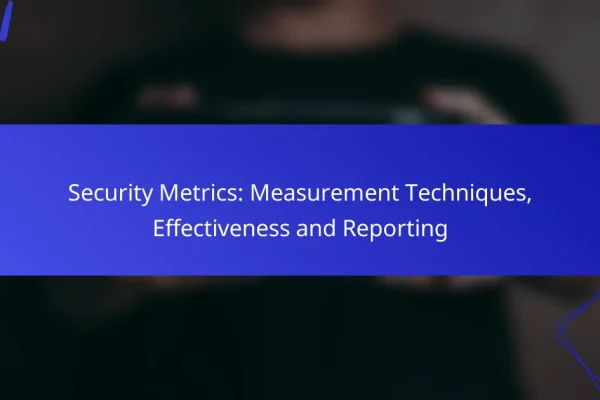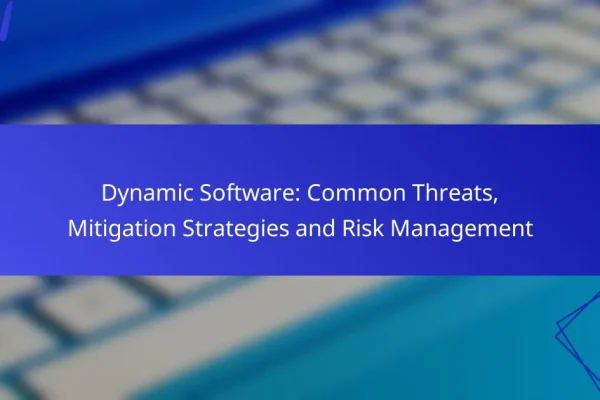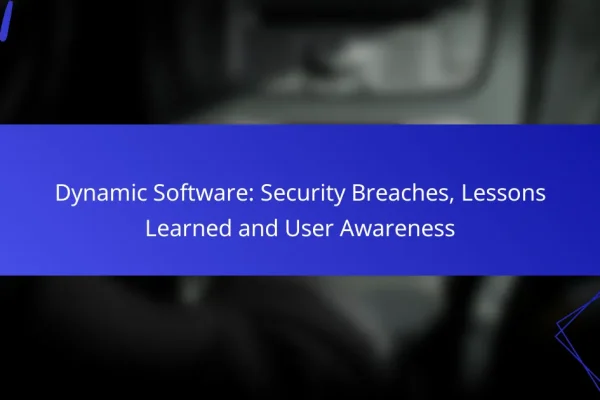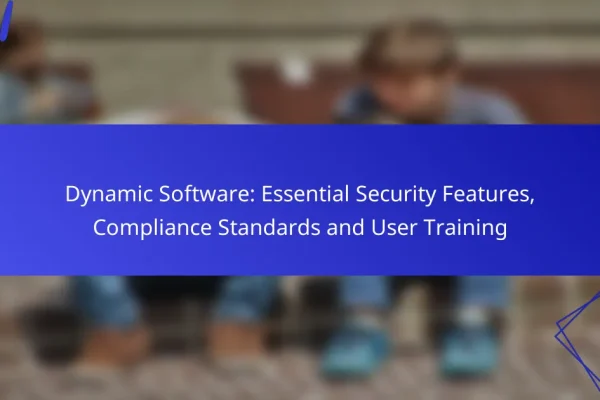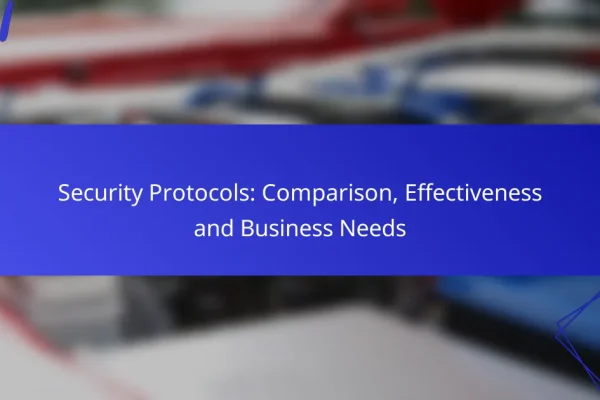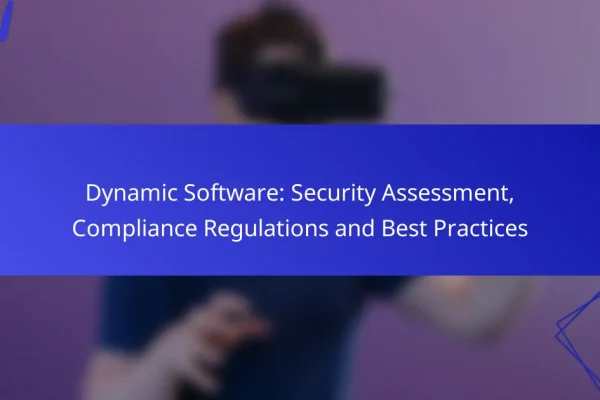What are the best dynamic software security measures?
The best dynamic software security measures include tools and practices that adapt to threats in real-time, ensuring ongoing protection for applications. These measures help identify vulnerabilities and respond to attacks as they occur, enhancing overall security posture.
Web Application Firewalls (WAF)
Web Application Firewalls (WAF) act as a barrier between web applications and potential threats, filtering and monitoring HTTP traffic. They can block malicious requests and protect against common attacks like SQL injection and cross-site scripting.
When implementing a WAF, consider whether to use a cloud-based or on-premises solution, as each has different cost implications and performance characteristics. Regularly update the WAF rules to adapt to new threats and ensure optimal protection.
Intrusion Detection Systems (IDS)
Intrusion Detection Systems (IDS) monitor network traffic for suspicious activity and known threats. They can be classified as either network-based or host-based, depending on whether they analyze traffic or system behavior.
To maximize effectiveness, configure the IDS to generate alerts for unusual patterns and regularly review logs for signs of breaches. Keep in mind that false positives can occur, so fine-tuning the system is essential for accurate detection.
Runtime Application Self-Protection (RASP)
Runtime Application Self-Protection (RASP) integrates security directly into the application runtime environment, allowing it to detect and respond to threats in real-time. This approach provides context-aware protection that traditional security measures may miss.
When choosing a RASP solution, look for one that offers comprehensive coverage of your application’s components and can easily integrate with existing development workflows. Regularly test the RASP implementation to ensure it effectively mitigates risks without impacting performance.
Behavioral Analytics Tools
Behavioral Analytics Tools analyze user behavior to identify anomalies that may indicate security threats. By establishing a baseline of normal activity, these tools can detect deviations that suggest potential breaches or insider threats.
Implementing behavioral analytics requires careful monitoring of user interactions and continuous adjustment of the baseline as user behavior evolves. Ensure that the tools comply with privacy regulations to protect user data while maintaining security.
Continuous Security Monitoring
Continuous Security Monitoring involves the ongoing assessment of security controls and vulnerabilities within an application. This proactive approach helps organizations quickly identify and remediate potential security issues before they can be exploited.
To effectively implement continuous monitoring, utilize automated tools that provide real-time insights and alerts. Regularly review security policies and update them based on the latest threat intelligence to maintain a robust security posture.
How do dynamic security measures protect against threats?
Dynamic security measures protect against threats by continuously monitoring systems and adapting to emerging risks in real-time. These measures enhance traditional security protocols by incorporating automated responses and evolving policies based on detected vulnerabilities.
Real-time threat detection
Real-time threat detection involves the continuous analysis of network traffic and user behavior to identify potential security breaches as they occur. By leveraging machine learning algorithms and behavioral analytics, organizations can spot anomalies that may indicate a cyber attack.
Implementing tools like intrusion detection systems (IDS) and security information and event management (SIEM) solutions can significantly enhance threat visibility. Regularly updating these systems ensures they can recognize the latest threats, which is crucial for maintaining security integrity.
Automated response mechanisms
Automated response mechanisms enable organizations to react swiftly to detected threats without human intervention. This can include isolating affected systems, blocking malicious IP addresses, or deploying patches to vulnerable software.
For effective automation, organizations should define clear incident response protocols and integrate them with their security tools. This ensures that when a threat is identified, the appropriate actions are taken promptly, minimizing potential damage.
Adaptive security policies
Adaptive security policies adjust security measures based on current threat landscapes and organizational needs. These policies can evolve in response to new vulnerabilities, regulatory changes, or shifts in business operations.
To implement adaptive policies, organizations should conduct regular risk assessments and update their security frameworks accordingly. This proactive approach helps ensure compliance with standards such as GDPR or HIPAA while addressing specific threats relevant to their industry.
What are the key features of effective dynamic security solutions?
Effective dynamic security solutions are characterized by their adaptability, integration capabilities, and robust reporting features. These solutions continuously assess and respond to threats in real-time, ensuring that security measures evolve alongside emerging risks.
Scalability and flexibility
Scalability and flexibility are crucial for dynamic security solutions, allowing them to grow with an organization’s needs. A scalable solution can handle increasing amounts of data and users without compromising performance, while flexibility ensures that the system can adapt to new threats and technologies.
For instance, a cloud-based security solution can easily scale up to accommodate a growing user base or increased data traffic. Organizations should evaluate solutions that offer modular components, enabling them to add or remove features as necessary.
Integration with existing systems
Integration with existing systems is essential for seamless security management. Effective dynamic security solutions should work harmoniously with current IT infrastructure, including firewalls, intrusion detection systems, and identity management tools.
Choosing solutions that support standard protocols and APIs can simplify integration. Organizations should prioritize solutions that offer compatibility with their existing software to avoid disruptions and ensure a unified security posture.
Comprehensive reporting and analytics
Comprehensive reporting and analytics provide valuable insights into security performance and threat landscapes. Effective dynamic security solutions should offer detailed reports on security incidents, vulnerabilities, and compliance status, enabling organizations to make informed decisions.
Look for solutions that provide real-time dashboards and customizable reporting options. This allows security teams to quickly identify trends, assess risks, and allocate resources effectively, ultimately enhancing the organization’s security strategy.
What criteria should be used to select dynamic security software?
When selecting dynamic security software, prioritize criteria such as compliance with industry standards, cost-effectiveness, and vendor reputation. These factors ensure that the software not only meets regulatory requirements but also provides value and reliable support.
Compliance with industry standards
Dynamic security software must adhere to relevant industry standards to ensure it effectively protects sensitive data. Look for compliance with regulations such as GDPR, HIPAA, or PCI DSS, depending on your sector. This compliance not only mitigates legal risks but also enhances customer trust.
Check if the software includes features that facilitate compliance, such as data encryption, access controls, and audit trails. Regular updates to maintain compliance with evolving standards are also crucial.
Cost-effectiveness
Cost-effectiveness is a key consideration when choosing dynamic security software. Analyze both initial costs and ongoing expenses, including licensing fees, maintenance, and support. Aim for solutions that offer a balance between robust features and affordability.
Consider the potential return on investment (ROI) by evaluating how the software can reduce risks and prevent costly breaches. A solution that minimizes downtime and enhances operational efficiency can justify a higher upfront cost.
Vendor reputation and support
The reputation of the vendor plays a significant role in the effectiveness of dynamic security software. Research customer reviews, case studies, and industry awards to gauge the vendor’s reliability and performance. A well-regarded vendor is more likely to provide a quality product and responsive support.
Evaluate the level of customer support offered, including availability of technical assistance, training resources, and community forums. Reliable support can significantly impact your experience, especially during critical incidents or software updates.
What are the challenges in implementing dynamic security measures?
Implementing dynamic security measures presents several challenges, including the complexity of integration with existing systems, the need for adequate resource allocation and training, and the potential impact on system performance. Addressing these challenges is crucial for effective security management.
Complexity of integration
Integrating dynamic security measures into existing systems can be complicated due to varying architectures and technologies. Organizations must ensure that new security protocols work seamlessly with legacy systems, which may require extensive customization and testing.
To simplify integration, consider adopting modular security solutions that can be implemented incrementally. This approach allows for gradual adjustments and minimizes disruption to ongoing operations.
Resource allocation and training
Effective implementation of dynamic security measures demands significant resources, including skilled personnel and financial investment. Organizations often face difficulties in allocating budget and time for training staff on new security protocols and tools.
To mitigate these issues, prioritize training programs that focus on practical applications of dynamic security measures. Investing in ongoing education can enhance staff competency and reduce the risk of security breaches.
Maintaining system performance
Dynamic security measures can impact system performance, potentially leading to slower response times or reduced user experience. Balancing security needs with performance requirements is essential to avoid frustrating users and hindering productivity.
To maintain optimal performance, conduct regular assessments of security measures and their effects on system speed. Implementing solutions that offer adjustable security levels can help tailor protection without compromising efficiency.
What are the emerging trends in dynamic software security?
Emerging trends in dynamic software security focus on real-time threat detection, adaptive security measures, and integration of artificial intelligence. These trends aim to enhance the resilience of software systems against evolving cyber threats.
Real-time threat detection
Real-time threat detection involves monitoring software systems continuously to identify vulnerabilities and attacks as they occur. This proactive approach allows organizations to respond immediately to potential breaches, minimizing damage. Technologies such as intrusion detection systems (IDS) and security information and event management (SIEM) tools are commonly used for this purpose.
To implement effective real-time threat detection, organizations should prioritize the integration of automated monitoring tools that can analyze vast amounts of data quickly. Regular updates and tuning of detection algorithms are crucial to adapt to new threats.
Adaptive security measures
Adaptive security measures adjust dynamically based on the current threat landscape and system behavior. This approach allows security protocols to evolve in response to detected anomalies, ensuring that defenses remain robust against new attack vectors. Techniques such as machine learning can enhance the adaptability of security systems.
Organizations should consider employing a layered security strategy that incorporates adaptive measures, such as automated patch management and behavior-based access controls. Regular assessments of security policies will help ensure they remain effective in a changing environment.
Integration of artificial intelligence
The integration of artificial intelligence (AI) in dynamic software security enhances the ability to predict, detect, and respond to threats. AI algorithms can analyze patterns and identify anomalies that may indicate a security breach, often faster than human analysts. This capability significantly improves the overall security posture of software systems.
When implementing AI-driven security solutions, organizations should focus on training models with diverse datasets to improve accuracy. It is also essential to maintain human oversight to validate AI findings and ensure appropriate responses to detected threats.
